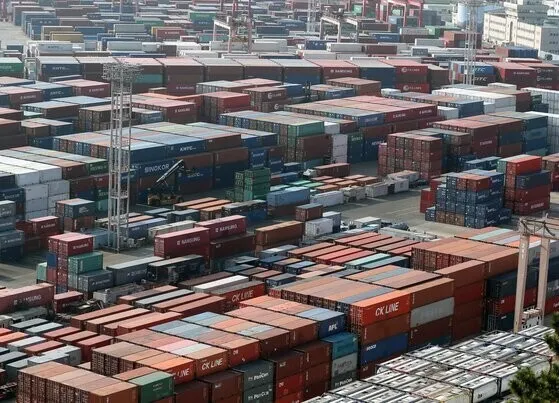hankyoreh
Links to other country sites 다른 나라 사이트 링크
Korea faces longest trade deficit in 26 years as exports shrink for 7 months in a row

South Korean exports have been shrinking for seven consecutive months due to the ongoing slump in semiconductors and petrochemicals, the country’s leading export products.
Korea has posted a trade deficit for 14 months in a row, amounting to a cumulative trade deficit well above US$25 billion.
According to a report on import and export trends in April that was released by Korea’s Ministry of Trade, Industry and Energy on May 1, Korea posted US$49.62 billion in exports last month, down 14.2% from the same month last year.
That was the seventh consecutive month that exports shrank year over year since last October. Significantly, the scope of the decline has been increasing since February (-7.6%).
The export slump was led by the semiconductor sector once again last month. Exports of chips dropped 41% year over year to US$6.38 billion.
Displays, another major export item, were down 29.3% over the same period, while petroleum products (-27.3%) and petrochemicals (-23.8%) both fell by more than 20% as unit prices were dragged down by weak oil prices.
In contrast, automobile exports increased by 40.3% to US$6.16 billion over the same period, a record in terms of export value. Ship exports also posted robust growth of nearly 60%.
Broken down by region, there were significant declines in exports to China (-26.5%) and the ASEAN countries (-26.3%), while exports to the US decreased by 4.4%.
Korea’s exports to Europe rose by 9.9%, backed by an increase in automobile exports, and exports to the Middle East shot up by 30.7%, led by exports of general machinery.
While imports also fell by 13.3%, the drop in exports was much greater, resulting in a trade deficit of US$2.92 billion last month.
Korea’s trade balance has been in negative territory for 14 consecutive months (adding up to US$25.06 billion) since a surplus gave way to a deficit last March. That’s Korea’s longest-running deficit since the 17-month period from January 1995 to May 1997.
That said, the monthly deficit has been narrowing each month since January (US$12.69 billion). Korea’s February and March deficits were US$5.3 billion and US$4.63 billion, respectively.
The accumulating trade deficit is provoking anxiety in the foreign exchange market. That’s not only because of the decreasing supply of dollars brought in by exports, but also because it raises questions about the basic vitality of the Korean economy.
As of Monday, the won-dollar exchange rate stood at 1,339.9 won per dollar, up 9.9% (120.6 won) from this year’s low (Feb. 3).
The Ministry of Trade, Industry and Energy expects an upswing in the semiconductor sector and a corresponding surplus in the trade balance starting in the third quarter (July-September) in light of production cuts at Samsung Electronics and other major memory chipmakers that should clear up the supply glut.
“We expect that semiconductor exports will see a partial recovery in the second half of the year. Overall, we expect to transition to a trade surplus and export growth around that time, with the trade surplus rebound coming a little earlier than the transition to export growth,” said Kim Wan-ki, director general for international trade affairs at the ministry, in a press briefing Monday.
By Ock Kee-won, staff reporter
Please direct questions or comments to [english@hani.co.kr]

Editorial・opinion
![[Editorial] Constitutional Court must at long last remove Yoon [Editorial] Constitutional Court must at long last remove Yoon](https://flexible.img.hani.co.kr/flexible/normal/500/300/imgdb/original/2025/0402/2617435819121664.jpg) [Editorial] Constitutional Court must at long last remove Yoon
[Editorial] Constitutional Court must at long last remove Yoon![[Column] Don’t let insurrectionists gaslight you [Column] Don’t let insurrectionists gaslight you](https://flexible.img.hani.co.kr/flexible/normal/500/300/imgdb/original/2025/0331/1917434093426857.jpg) [Column] Don’t let insurrectionists gaslight you
[Column] Don’t let insurrectionists gaslight you- [Column ] The obscenity of Trump’s ‘hasbara’
- [Column] In the name of Korean democracy, I rebuke Yoon Suk-yeol!
- [Column] A country free from the threat of military coup d’etats
- [Column] The world without America
- [Column] Lessons for Korea from America’s Chinese Exclusion Act
- [Editorial] Fear of far-right violence grows as verdict on Yoon’s impeachment is delayed
- [Column] The defeat of America
- [Column] Standing atop the ruins of Korean democracy
Most viewed articles
- 1Arrests, deportations of US green card holders send chill through Korean community
- 2The case against Yoon: 5 counts court will weigh in climactic decision on his impeachment
- 3Yoon’s day of reckoning: Experts predict court will oust impeached president on Friday
- 4Embassies in Korea warn of social disturbances ahead of impeachment ruling
- 5Understanding the Constitutional Court’s standards for upholding impeachment
- 6Korea has an FTA with US, Japan doesn’t – guess which faces higher tariffs under Trump
- 7It’s time Korea prepares itself for a peninsula without the US, expert advises
- 8Trump slaps 25% tariff on all Korean goods imported to US
- 9[Column ] The obscenity of Trump’s ‘hasbara’
- 10[Editorial] Constitutional Court must at long last remove Yoon